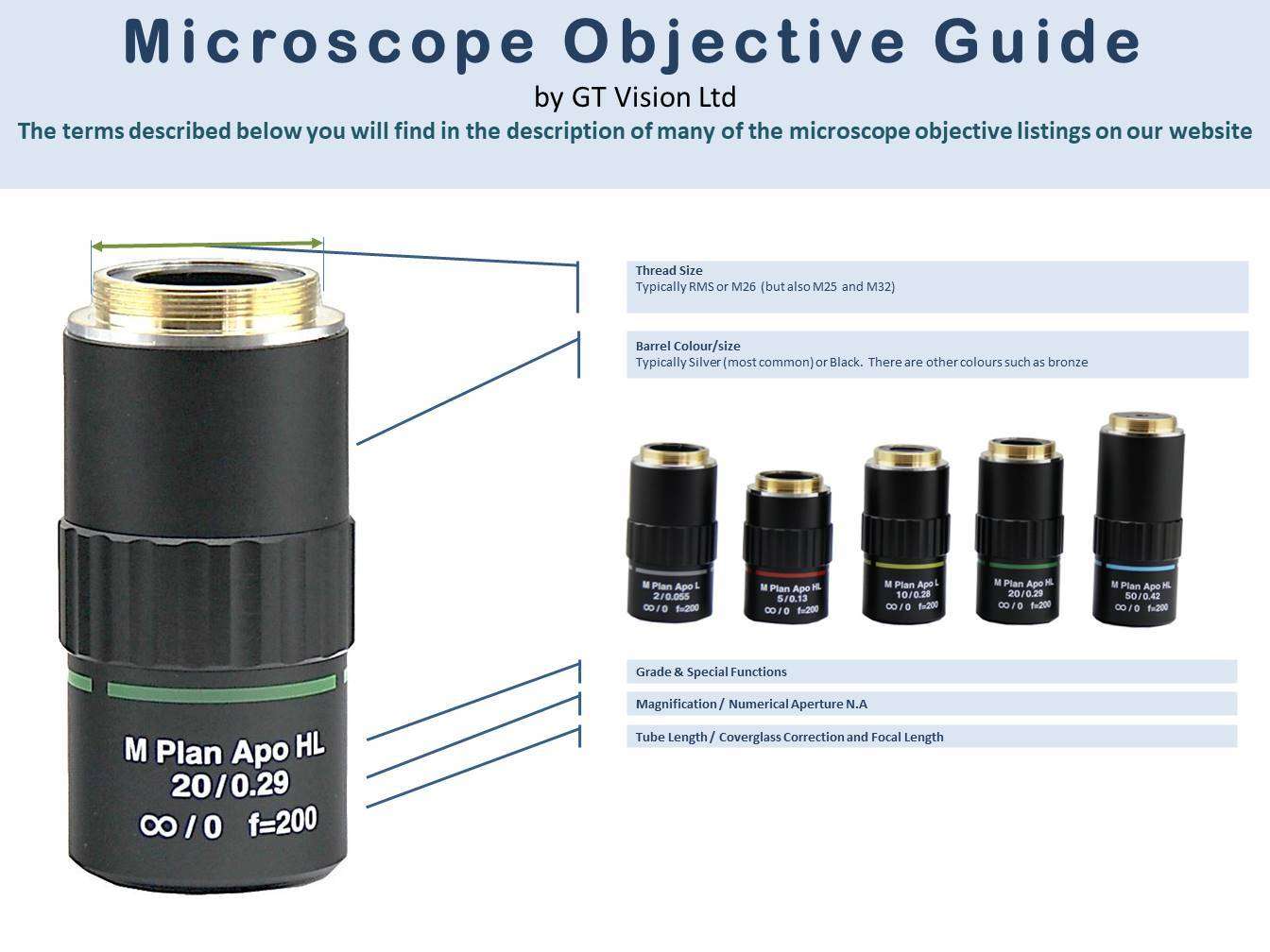| PARAMETER |
EXAMPLE VALUES |
DEFINITIONS |
| Product Code |
0307 |
A unique product identifier |
| Magnification |
4X |
the meaning of this is self evident |
| Features |
Brightfield |
Any special features such as phase contrast, fluorescence etc. Brightfield is the most common biological type. |
| Designed For |
Biological Upright Microscopes |
Which type of microscope this objective is most commonly used on |
| Objective Grade |
Grade 5 – Plan Achromatic |
GRADE NUMBER:-
1 – lowest possible grade, cheap, found mainly on toys, not even achromatic
2 – basic glass objective with steel barrel, reasonable quality found on schools microscopes, usually a narrow barrel, all achromatic
3 – education grade, normal width barrel, better quality found on many secondary level and college teaching and amateur microscopes, typically achromatic
4 – routine grade, suitable for most uses, good quality, typically semi-plan achromatic
5 – suitable for research and routine use, high quality
6 – research grade optics
7 – very high quality, exrtemely good image resolution
8 – about as good as it gets
FIELD FLATNESS & COLOUR CORRECTION (improving quality as you descend the list):-
ACHROMATIC – the most basic class of microscope objective but they can still give good quality images. Achromats are corrected for chromatic aberration of two colours , red and blue.
SEMI PLAN ACHROMATIC – Slightly better than Achromatics with a flatter image at the edges.
PLAN ACHROMATIC – Better still with a substantially flat image
SEMI-PLAN APOCHROMATIC (also PLAN FLUORITE) – A superior class of objective giving a high order of correction for all three colours with higher resolution
APOCHROMATIC – Corrected both chromatically and spherically for all three colours combined with special additional correction for field curvature |
| Numerical Aperture (N.A.) |
0.1 |
The Numerical Aperture of a microscope objective is the measure of its ability to gather light and to resolve fine specimen detail It is influenced by the media through which light travels in front of the objective (oil immersion objectives give a higher NA for instance). |
| Coverglass Correction |
0.17 mm |
Most higher magnification biological microscope objectives are corrected for the effect of the refractive index of the coverslip placed over a specimen, usually the thickness is 0.17mm. With inverted micrscope you may be looking through the bottom of flasks hence a larger correction thickness of, for example, 1.2mm.
Materials microscope specimens are rarely covered and require no correction, hence the value or 0 or – |
| Thread Size |
RMS |
RMS is the most common thread size (20.32mm in diameter) for a microscope objective, the second-most common is M26 (26mm). Other sizes are also used. It is essential to match the thread size with your microscope objective turret in which the fit. |
| Working Distance (W.D.) |
21.0 mm |
The general rule is that the lower the magnification the longer is the working distance. However, to maintain ‘parfocality’ on a turret of objectives, the working distance will often tailored so the sum of the barrel length and working distance for all objectives of the same type will give precisely the same value. Special longer working distance objectives usually have an extra ‘L’ written on the barrel. |
| Tube Length |
Infinity |
Mechanical Tube Length. This must match on all objectives on a turret of objectives and it must match the specification of the microscope. This is the length of the microscope body tube between the nosepiece thread mounting hole, where the objective is attached, and the top edge of the eyepiece tubes where the eyepieces are inserted. 160 and Infinity are the most common. This value is not necessarily an indication of quality. |
| Parfocal Distance |
45 mm |
Designed to reduce the need for refocussing when different objectives are selected on a turret of objectives. Mosty it is 45mm. It is the distance from the top of the objective barrel when inserted to the point on the subject that is in focus. |
| Focal Length |
Unspecified |
Rarely used as focal lengths normal pertain to a single lens system and objectives have several lenses |
| Barrel Colour / Size |
Silver / Standard |
This has no significance. There are colour bands corresponding to magnifications however. |
| Brand |
GX Microscopes |
|
| Condition |
New |

